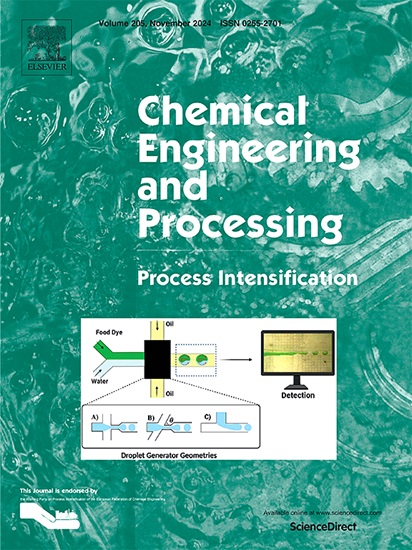Optimization of a two-stage axial-flow cyclone separator focusing on energy consumption and separation efficiency
IF 3.8
3区 工程技术
Q3 ENERGY & FUELS
Chemical Engineering and Processing - Process Intensification
Pub Date : 2025-07-02
DOI:10.1016/j.cep.2025.110432
引用次数: 0
Abstract
The miniature two-stage axial flow cyclone separator (AFCS) developed for the gas-liquid separation system in the dry gas seal of large centrifugal compressors faces challenges such as low separation efficiency and high energy consumption. This study addresses these issues by optimizing the AFCS design, focusing on blade angles, exhaust pipe insertion depth, and diameter, using a combination of numerical simulation (RSM and DPM) and experimental methods. Additional measures, such as using anti-backmixing cones and slitting in the cone area of the exhaust pipe, were also explored to evaluate their effects on separation efficiency and energy consumption. The results show that the insertion depth and diameter of the exhaust pipe are optimal when they are 18 mm and 20 mm respectively. The separation efficiency can be increased by 1 ∼ 2 % and the pressure drop can be reduced by 20 kPa by using anti-backmixing cone and slit. Compared with the original two-stage AFCS, the drip stage efficiency of the optimized separator can be increased by 50 %, the separation efficiency can be increased by 10 %, and the pressure drop can be reduced by 20 %, solving the problems of low separation efficiency and high energy consumption of the single-stage separator.

以能耗和分离效率为重点的两级轴流旋风分离器优化
为大型离心压缩机干气密封气液分离系统开发的小型两级轴流旋风分离器(AFCS)面临着分离效率低、能耗高的挑战。本研究采用数值模拟(RSM和DPM)和实验相结合的方法,通过优化AFCS设计来解决这些问题,重点关注叶片角度、排气管插入深度和直径。此外,还探讨了采用防反混锥和在排气管锥区开缝等附加措施对分离效率和能耗的影响。结果表明:排气管插入深度为18 mm,直径为20 mm时最优;采用防反混锥缝可使分离效率提高1 ~ 2%,压降降低20 kPa。与原两级AFCS相比,优化后的分离器滴滤级效率可提高50%,分离效率可提高10%,压降可降低20%,解决了单级分离器分离效率低、能耗高的问题。
本文章由计算机程序翻译,如有差异,请以英文原文为准。
求助全文
约1分钟内获得全文
求助全文
来源期刊
CiteScore
7.80
自引率
9.30%
发文量
408
审稿时长
49 days
期刊介绍:
Chemical Engineering and Processing: Process Intensification is intended for practicing researchers in industry and academia, working in the field of Process Engineering and related to the subject of Process Intensification.Articles published in the Journal demonstrate how novel discoveries, developments and theories in the field of Process Engineering and in particular Process Intensification may be used for analysis and design of innovative equipment and processing methods with substantially improved sustainability, efficiency and environmental performance.

 求助内容:
求助内容: 应助结果提醒方式:
应助结果提醒方式:


